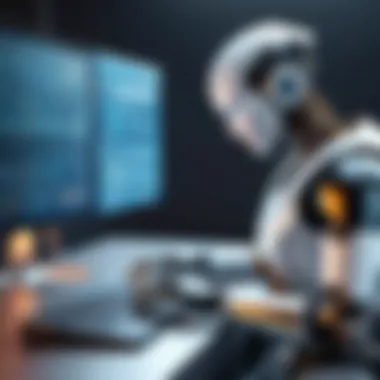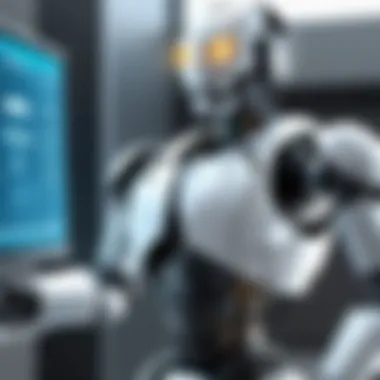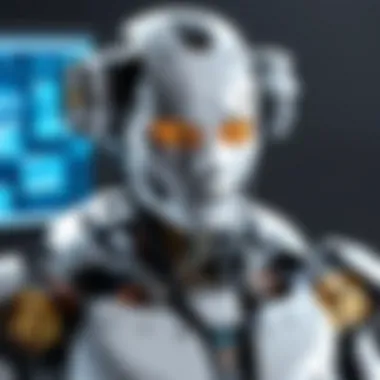Explore Robotic Operating System Courses for All Levels


Overview of Topic
Prologue to the main concept covered
The Robotic Operating System (ROS) is a flexible framework for writing robot software. It is not an operating system in the traditional sense, but more accurately a collection of software frameworks that help build robot applications. This facilitates the development of robotic systems by providing tools, libraries, and conventions.
Scope and significance in the tech industry
As automation and robotics increasingly become integral to various sectors, knowledge of ROS is invaluable. Industries ranging from manufacturing to healthcare leverage robotic systems, and developers proficient in ROS can drive innovation and efficiency in these fields. Familiarity with this system offers a competitive edge in today’s job market.
Brief history and evolution
Originally developed in 2007 by Willow Garage, ROS has undergone significant evolution. It has transitioned from a niche tool to a widely adopted platform in robotics. The introduction of the Robot Operating System 2 (ROS 2) provided improved support for real-time systems and expanded capabilities, highlighting its growth.
Fundamentals Explained
Core principles and theories related to the topic
Understanding ROS begins with grasping the core principles that govern its operation. Notably, communication between various components in a robotic system is central.
Key terminology and definitions
- Nodes: These are individual processes that perform computation.
- Topics: Nodes communicate with each other via messaging through topics.
- Services: These provide a synchronous interface for communication between nodes.
Basic concepts and foundational knowledge
To work effectively with ROS, one must also understand the importance of packages. A package is a structured directory that includes ROS code, libraries, and configuration files. This structure allows for modular development.
Practical Applications and Examples
Real-world case studies and applications
Many companies implement ROS in their robotic systems. For instance, Clearpath Robotics uses it in their mobile robots for navigation and task execution. This illustrates the versatility of ROS in practical scenarios.
Demonstrations and hands-on projects
Beginner courses often include simple projects, such as simulating robots in Gazebo, a 3D simulation environment. This practical experience provides learners with an immediate application of theoretical knowledge.
Code snippets and implementation guidelines
Here is an example of initializing a simple ROS node:
This code snippet demonstrates the basic setup needed to create a node.
Advanced Topics and Latest Trends
Cutting-edge developments in the field
Current trends indicate a growing interest in integrating artificial intelligence with ROS. Such integration significantly enhances the decision-making capabilities of robots.
Advanced techniques and methodologies
Advanced courses cover topics such as The Robot Operating System for Embedded Systems, which focuses on implementing ROS in hardware-constrained environments.
Future prospects and upcoming trends
The future of ROS looks promising, with an increasing number of applications emerging in autonomous vehicles and drones. As technology advances, learning ROS will likely remain a highly relevant skill.
Tips and Resources for Further Learning
Recommended books, courses, and online resources


- Programming Robots with ROS by Morgan Quigley
- The official ROS tutorials on the ROS Wiki
- Online platforms like Coursera and Udacity offer structured courses.
Tools and software for practical usage
Utilizing GitHub to explore and contribute to ROS packages can greatly enhance learning. Additionally, software like RViz, for visualization, is essential for developers.
To grasp the full potential of ROS, continuous learning and hands-on experience are essential.
Overview of Robotic Operating System
Understanding the Robotic Operating System (ROS) is crucial in today’s rapidly evolving field of robotics. This section provides a foundational perspective that supports the deeper exploration of ROS courses. By grasping the overview, potential learners can appreciate the significance of these courses and the knowledge they will gain.
Definition of Robotic Operating System
Robotic Operating System, commonly referred to as ROS, is an open-source framework designed for robot software development. It provides essential tools and libraries necessary for creating robotic applications. Unlike traditional operating systems, ROS does not directly control the hardware. Instead, it offers a set of software libraries and tools that simplify the development of robot software. This allows developers to focus on the capabilities of their robots rather than the underlying complexities of the operating system itself. ROS supports a range of functionalities, including hardware abstraction, low-level device control, implementation of commonly used functionality, and message-passing between processes.
Importance of ROS in Robotics
The role of ROS in robotics cannot be understated. Its significance is derived from several factors:
- Standardization: ROS provides a standardized framework that allows different developers to work on projects collaboratively. This is particularly important in research and development environments, where various systems need to communicate effectively.
- Community Support: As an open-source project, ROS benefits from a large and active community that contributes to its continuous improvement. This community fosters an environment of shared knowledge and resources, allowing learners to access a wealth of information.
- Wide Adoption: Many commercial and academic institutions utilize ROS. This widespread adoption indicates that knowledge of ROS can enhance career opportunities in robotics. Familiarity with this framework is often a requirement for positions in the field.
"ROS is not just a tool, but a vital ecosystem that connects innovative minds in robotics."
Learning ROS opens doors to various applications, from simple robotic arms to complex autonomous systems. For beginners and professionals alike, understanding ROS's foundational principles is essential to thrive in the robotics landscape.
Target Audience for the Course
Identifying the target audience for a Robotic Operating System (ROS) course is crucial to tailoring content and teaching methods that resonate with learners. Understanding who will engage with the material ensures that these courses are structured to meet the unique needs and skill levels of each segment. The audience can be broadly classified into beginners and intermediate learners or professionals, each requiring different pedagogical approaches.
Beginners in Robotics
Beginners in robotics often come with varying levels of familiarity with technology. They may be students in academic programs or amateurs motivated by a passion for the field. \nTheir primary goals include understanding the foundational concepts of robotics and developing basic skills in programming and system integration. A well-structured ROS course for beginners focuses on the following key components:
- Basic Theory: Introducing the fundamental principles of robotics, including mechanics, electronics, and programming workflows.
- Hands-On Activities: Implementing practical exercises using simulation tools, such as Gazebo, allows students to visualize robotic functions in a controlled environment.
- Resources for Exploration: Providing access to supplementary materials, like books or online content, enables learners to explore topics at their own pace.
The benefits of engaging beginners in ROS are clear. It nurtures interest in robotics while empowering learners with vital skills that are valuable in today’s job market.
Intermediate Learners and Professionals
Intermediate learners and professionals typically possess some prior knowledge of robotics or experience in related fields. They might be working in engineering, IT, or automation, seeking to enhance their competencies and apply ROS in real-world projects. For this audience, successful ROS courses should emphasize:
- Advanced Concepts: Topics like sensor integration and robot perception, which build upon the basics and challenge these learners to think critically and solve complex problems.
- Integration into Existing Systems: Practical projects that involve real hardware, allowing learners to apply theory in practical scenarios and seamlessly merge ROS with familiar technologies.
- Networking Opportunities: Courses that provide collaboration with peers and access to industry professionals help expand their professional circle, which is beneficial for future career advancements.
A well-designed course can significantly impact their understanding, making it easier for them to innovate and lead in robotics technologies.
"The true advancement in robotics comes from understanding how to leverage tools like ROS effectively."
In summary, recognizing the distinct needs of these two groups allows course creators to develop relevant, engaging content that fosters a deep understanding and practical application of the Robotic Operating System.
Core Curriculum Components
The section on Core Curriculum Components serves as a foundation for understanding the necessary subjects within Robotic Operating System courses. This curriculum is designed to equip learners with both theoretical knowledge and practical skills to navigate the intricate world of robotics. Each component focuses on essential aspects of ROS, promoting the development of robust robotics applications.
Prelude to Robotics
The study of robotics encompasses various disciplines, including mechanical engineering, electrical engineering, and computer science. In this introductory section, students will explore fundamental concepts integral to robotics. This includes understanding the types of robots, their components, and how they operate.
Through practical examples and case studies, learners will gain insight into the principles that govern robot design and function. This foundational knowledge is crucial as it lays the groundwork for more advanced topics in ROS.
Basic Architecture of ROS
The Basic Architecture of ROS is essential for students to grasp how robotic systems function at a basic level. ROS is composed of various modules and tools that work together, allowing different robots to communicate and share data effectively. This architecture includes nodes, topics, and services, which form the core communication framework of ROS.
Familiarizing oneself with this framework enables beginners to utilize ROS confidently. Understanding its architecture helps learners appreciate how components interact within robotic systems, thereby enhancing their programming and debugging skills.


Node and Topic Concepts
In Robotics, nodes are individual processes that perform computation, while topics are channels through which nodes exchange information. This section explains these two critical concepts in detail. Nodes can publish or subscribe to topics, facilitating communication between various parts of a robotic system.
Students will learn how to create nodes and set up topics for effective data transfer. They will also explore best practices for designing topics to ensure smooth interaction among nodes. Mastery of this concept is paramount for anyone looking to develop functional robotic applications.
Services and Actions in ROS
Services and actions provide additional mechanisms for communication beyond topics. Services allow for synchronous communication, where a request is sent, and a response is received, while actions enable asynchronous communication, suitable for tasks that take longer to complete.
Understanding these mechanisms is vital for complex applications where robots need to perform tasks based on input data or return results upon completion of processes. This section reinforces the significance of services and actions in designing responsive and efficient robotic systems.
Learning to employ both services and actions can greatly enhance the functionality of ROS applications and improve user experience.
By focusing on the Core Curriculum Components, this section aims to establish strong theoretical and practical grounding in Robotics. It ensures that learners acquire the necessary skills to build, program, and operate robotic systems effectively, preparing them for both academic and professional success.
Practical Applications of ROS
The practical applications of the Robotic Operating System (ROS) serve as a vital conduit between theory and real-world utilization in robotics. Understanding these applications enables students and professionals to visualize how concepts learned in course materials translate to tangible outcomes. This section will focus on two primary aspects: simulation and hardware integration, which are crucial for effective robotics deployment.
Simulation with Gazebo
Gazebo is a powerful robot simulation tool widely used with ROS. It provides a robust environment for testing algorithms, designing robots, and training AI. Students can create and manipulate complex environments and scenarios without needing physical hardware. This aspect of robotic education is paramount when evaluating designs or algorithms in a safe and cost-effective manner.
Benefits of Using Gazebo:
- Cost Efficiency: No need for expensive hardware during the initial stages of development.
- Risk reduction: Failures in a simulated environment lead to no physical damage or injuries.
- Rapid Prototyping: Users can quickly make adjustments and test new ideas.
- Detailed Physics Modeling: Simulates real-world behaviors, providing better insights into how robots will perform.
Using Gazebo also allows students to focus on learning ROS commands and robotics fundamentals without the initial financial or logistical concerns of acquiring hardware. It prepares learners for real-world challenges by letting them understand and address problems before interacting with physical systems.
Integration with Hardware
Integrating ROS with hardware is crucial for understanding how theoretical knowledge applies to physical systems. This process requires knowledge of both hardware and software components. Hands-on experiences are key in bridging these disciplines, where students can connect sensors, motors, and control systems to their ROS setup.
Key Considerations:
- Knowledge of Hardware Interfaces: Understanding how to communicate with various parts, such as sensors from SparkFun or motors from Pololu.
- Debugging Skills: Real-time debugging of systems is an essential skill; students learn to troubleshoot communication issues between ROS and hardware.
- Flexibility in Design: Students learn to adapt their software to accommodate different types of hardware, which is valuable in the rapidly evolving field of robotics.
Integrating hardware with ROS provides a hands-on approach to learning that deepens the understanding of robotic behaviors and enhances problem-solving skills.
By engaging with both simulation and hardware integration, students not only grasp the theoretical underpinnings of robots but also gain applicable skills highly valued in the industry. This dual focus equips learners with a comprehensive understanding, preparing them for future challenges in robotics.
Advanced Topics in ROS
The study of Advanced Topics in the Robotic Operating System (ROS) is crucial for a comprehensive understanding of modern robotics. This area goes beyond basic programming and system architecture, delving into specialized fields that are shaping the future of robotics. Understanding these advanced concepts allows learners to enhance their capabilities in building intelligent, adaptive robotic systems. They also contribute to staying competitive in a rapidly evolving sector.
Robot Perception and Sensor Integration
Robot perception is a core component of robotics, allowing machines to interpret and interact with their environment. This involves understanding data collected from various sensors, such as cameras, LiDAR, and ultrasonic sensors. By effectively integrating these sensors, robots can gain situational awareness, which is vital for navigation and task execution.
For instance, a robot equipped with a camera and appropriate algorithms can identify obstacles in its path, while another equipped with LiDAR can map its surroundings three-dimensionally. Integrating multiple sensor inputs enhances accuracy and reliability, making perception robust against environmental variations.
Key considerations in sensor integration include:
- Calibration: Ensuring sensors are properly configured and aligned to provide accurate readings.
- Data Fusion: Combining data from multiple sources to create a unified perception of the environment.
- Real-Time Processing: Utilizing efficient algorithms to process sensor data quickly, allowing for immediate responses.
"Enhanced sensor integration is key to developing intelligent robots capable of operating in unpredictable environments."
Artificial Intelligence and Machine Learning in Robotics
The intersection of artificial intelligence (AI) and robotics is a rapidly growing field. Machine learning techniques enable robots to learn from data and improve their performance over time. This allows for adaptive behavior in unfamiliar situations, which is essential for autonomous operations.
Integrating AI with ROS can enhance various robotic functionalities:


- Autonomous Navigation: Robots can navigate complex environments using machine learning algorithms that continuously improve their path-planning strategies based on prior experiences.
- Object Recognition: Through supervised learning, robots become capable of recognizing and classifying objects, enabling them to interact appropriately with their surroundings.
- Predictive Maintenance: Employing machine learning to predict equipment failures can reduce downtime and increase operational efficiency.
In exploring these advanced topics, learners gain insights into how intelligent systems function and understand the potential applications across different sectors. The knowledge acquired prepares them for future challenges in robotics, allowing them to innovate and contribute to this dynamic field.
Learning Tools and Resources
Learning tools and resources play a crucial role in the effective absorption of knowledge regarding the Robotic Operating System (ROS). As the landscape of robotics continues to evolve, it is imperative for students and professionals to have access to the right materials that can facilitate learning. With various platforms available, it’s vital to consider both the quality and applicability of these resources. This section will discuss recommended software and simulators, as well as books and online resources essential for mastering ROS.
Recommended Software and Simulators
The choice of software and simulators can significantly impact one's grasp of the Robotic Operating System. Several options stand out for learners in this field:
- Robot Operating System (ROS) itself: This open-source framework serves as the backbone for many robotic applications. Familiarity with ROS can deepen one's understanding of underlying structures and functionalities.
- Gazebo: Gazebo is a powerful 3D simulation tool that integrates seamlessly with ROS. It provides a realistic environment to test algorithms, design robots, and simulate various scenarios without the need for physical hardware.
- RViz: RViz is a visualization tool that plays a pivotal role in displaying sensor data and robot state information. It aids learners in grasping complex data representations and enhances debugging processes.
These platforms not only allow for practicing theoretical knowledge but also enable hands-on experience, making them an indispensable part of the learning journey.
Best Books and Online Resources
Complementing software tools, books and online resources also serve to enrich learning in the realm of robotics. Here are notable recommendations:
- Books:
- Online Resources:
- Programming Robots with ROS by Morgan Quigley, Brian Gerkey, and William D. Smart. This book provides solid foundational knowledge in programming with ROS.
- Learning ROS for Robotics Programming by Aaron Martinez and Enrique Fernández. This work offers practical approaches to using ROS in real-world projects.
- The official ROS Wiki (http://wiki.ros.org) provides extensive documentation, tutorials, and community support. It is a vital resource for both beginners and experienced users.
- Codecademy and Coursera offer courses specifically focused on programming with ROS. These courses often combine theoretical insights with practical exercises, reinforcing learning.
Assessment and Evaluation Methods
Assessment and evaluation methods are crucial elements in any educational program, especially one focused on the Robotic Operating System (ROS). These methods ensure that learners are grasping the foundational principles and can apply them in practical scenarios. They also help instructors gauge the effectiveness of their teaching methods and the overall curriculum. A structured approach to assessments enables the identification of individual progress, which can inform tailored support for students who may be struggling.
Projects and Hands-On Assessments
Projects and hands-on assessments form the backbone of the learning experience in ROS courses. They provide an opportunity for students to engage with the material on a practical level, applying theory to real-world scenarios. This experiential learning is essential in robotics, where theoretical knowledge must often be translated into action.
Practical projects may include:
- Building a Simple Robot: Students get to construct a robot that performs basic tasks, integrating ROS for control and communication.
- Simulated Environments: Utilizing Gazebo or similar platforms allows students to experiment without the risks associated with physical hardware.
- Integration Projects: Connecting various sensors and actuators to the ROS framework helps bridge the gap between software and hardware.
Hands-on assessments are typically designed to push students to innovate and solve problems. This type of evaluation not only enhances technical skills but also encourages critical thinking and creativity. Additionally, the feedback from these projects can be invaluable in refining both the students' understanding and the course structure.
Online Quizzes and Feedback
Online quizzes and feedback mechanisms serve as a supplementary assessment strategy in ROS courses. They are designed to reinforce learning and promote retention of information. Quizzes typically cover theoretical aspects, ensuring students grasp key concepts before moving to more complex topics.
Key benefits of online quizzes include:
- Immediate Feedback: Quizzes provide instant results, allowing students to understand their strengths and weaknesses right away.
- Adaptive Learning Paths: Based on quiz performance, instructors can adapt future lessons to focus on areas needing improvement.
- Encouragement of Continual Engagement: Regular quizzes can motivate students to keep up with course materials, fostering a habit of continuous learning.
"Assessment is not just about grades, but about nurturing a deeper understanding of robotics and technology."
Culmination of the Course
The conclusion of the course plays a crucial role in emphasizing the learning journey taken by participants. It is here that students can synthesize their knowledge, understand the implications of what they learned, and explore pathways forward in the field of robotics. It also serves to anchor the skills acquired during the course in a real-world environment, preparing learners for future challenges and opportunities.
Future Opportunities in Robotics
The field of robotics is expanding rapidly. Graduates from Robotic Operating System courses find themselves in a position to access numerous career paths. These include software development for autonomous systems, research roles in artificial intelligence, and positions in industries ranging from healthcare to automotive.
Specific opportunities include:
- Robot software engineer: Focusing on developing algorithms and systems for robotic applications.
- Systems integration engineer: Bridging the gap between robotics hardware and software.
- AI researcher: Pushing the boundaries in machine learning as applied to robotics.
- Technical project manager: Leading teams to implement advanced robotic solutions.
The demand for skilled professionals in these areas is evident, with companies actively seeking individuals who can work with complex robotic systems.
Building a Portfolio with ROS Projects
Creating a strong portfolio is vital for anyone pursuing a career in robotics. Projects that showcase skills with the Robotic Operating System can significantly enhance a learner's marketability. Here are some critical aspects to consider when building such a portfolio:
- Diverse Project Selection: Include a variety of projects that display both technical aptitude and creative problem-solving. For example, a robotic arm project might highlight hardware understanding, while a simulation in Gazebo might showcase programming skills.
- Documentation and Presentation: Clearly document each project, describing the goals, challenges, and solutions. Good documentation enhances understanding and shows professionalism.
- Real-World Applications: Whenever possible, connect projects to real-world problems. This demonstrates not only technical skill but also a practical understanding of how robotics can impact various industries.
- GitHub Repository: Use GitHub to host projects. This not only allows for easy sharing but also demonstrates version control skills, which are essential in professional environments.
By effectively showcasing ROS projects, learners can distinguish themselves in a competitive market and illustrate their readiness to tackle challenges in the field of robotics.







